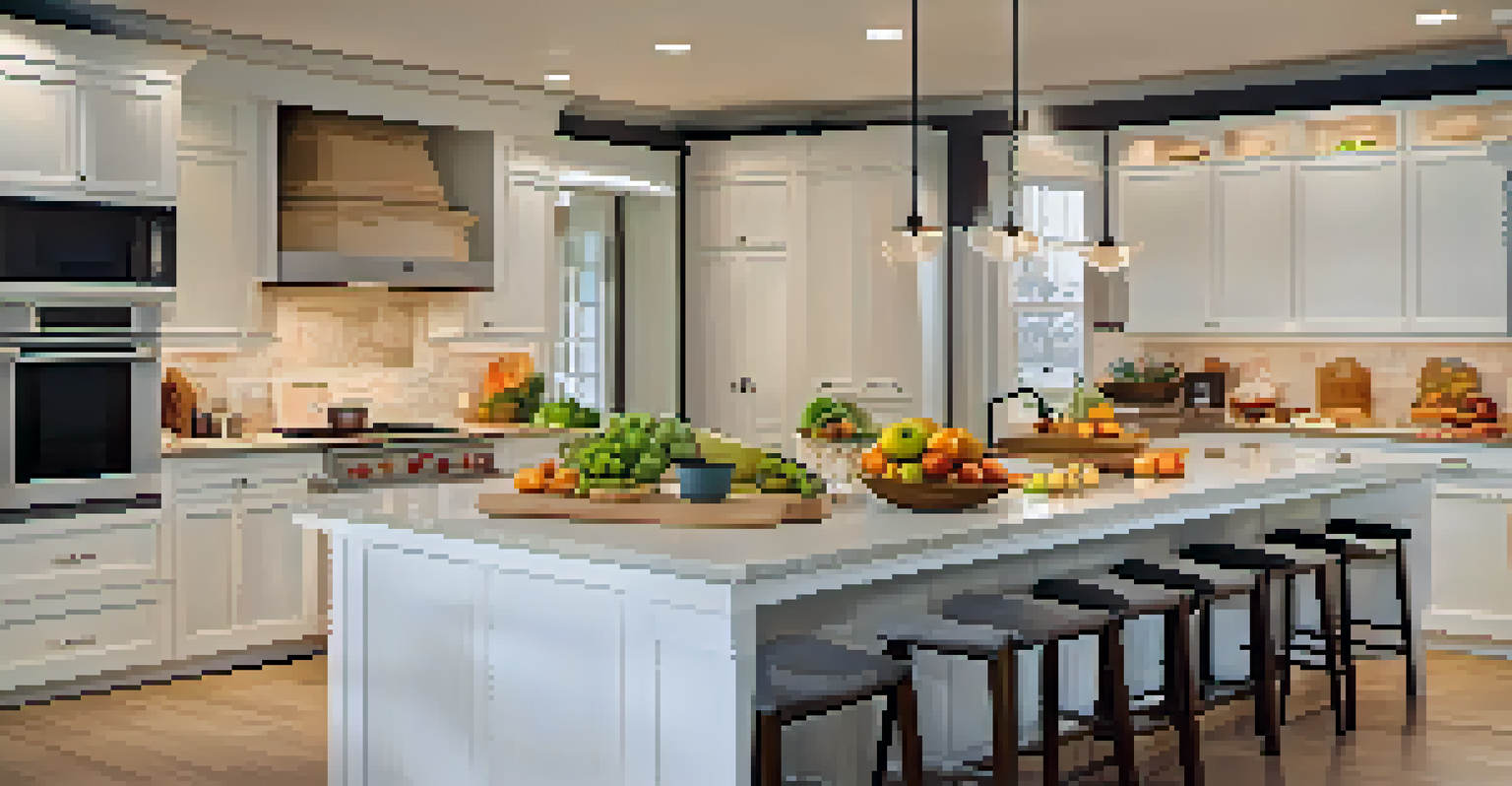Sustainable Flooring Options for Eco-Conscious Construction

Why Choose Sustainable Flooring for Your Construction Project?
Opting for sustainable flooring is not just a trend; it's a commitment to reducing environmental impact. By choosing eco-friendly materials, you contribute to a healthier planet and promote responsible consumption. Sustainable flooring options often come from renewable resources, making them a wise choice for any construction project.
The greatest threat to our planet is the belief that someone else will save it.
Moreover, these materials can improve indoor air quality, which is crucial for the health of occupants. Unlike traditional flooring, sustainable options tend to emit fewer volatile organic compounds (VOCs), making your space safer for everyone. This holistic approach to construction supports a sustainable lifestyle from the ground up.
Ultimately, the choice of flooring can significantly affect the overall sustainability of your project. It's about creating spaces that are not only beautiful but also beneficial to the environment. With so many options available today, it’s easier than ever to make a positive impact.
Bamboo Flooring: A Fast-Growing Eco-Friendly Choice
Bamboo flooring is gaining popularity as a sustainable option due to its rapid growth rate. Unlike hardwood trees that can take decades to mature, bamboo can grow back in just a few years after harvesting. This makes it a renewable resource that can be harvested without depleting forests.

In addition to being environmentally friendly, bamboo flooring is incredibly durable and resistant to moisture. This resilience makes it suitable for various applications, including kitchens and bathrooms, where water exposure is common. Plus, its unique aesthetic adds a touch of elegance to any space.
Sustainable Flooring Benefits
Choosing sustainable flooring options reduces environmental impact and promotes healthier indoor spaces.
However, it’s essential to choose bamboo flooring that is certified by organizations like the Forest Stewardship Council (FSC). This certification ensures that the bamboo is sourced sustainably, further enhancing its eco-credentials. By selecting high-quality bamboo, you can enjoy its beauty and sustainability for years to come.
Cork Flooring: Sustainable and Comfortable Underfoot
Cork flooring is another excellent sustainable option that is both comfortable and eco-friendly. Harvested from the bark of cork oak trees, this material can be collected without harming the tree, allowing it to regenerate over time. This unique harvesting process makes cork a renewable resource that supports forest conservation.
Sustainability is no longer about doing less harm. It’s about doing more good.
In addition to its sustainability, cork flooring provides natural insulation, helping to maintain comfortable temperatures in your home. It also has sound-absorbing properties, making it a great choice for reducing noise in busy households. With its soft, cushioned surface, cork is a delight to walk on.
Moreover, cork is naturally resistant to mold and mildew, adding an extra layer of health benefits to your space. When choosing cork flooring, look for options that are treated with environmentally friendly finishes to ensure a safer indoor environment. With its blend of comfort and sustainability, cork flooring is a smart choice for eco-conscious construction.
Reclaimed Wood: Charm with a Sustainable Backstory
Reclaimed wood flooring offers a unique way to incorporate sustainability into your building project while adding character to your space. Sourced from old barns, factories, or other structures, reclaimed wood gives new life to materials that would otherwise end up in landfills. This not only reduces waste but also preserves the rich history embedded in each plank.
Using reclaimed wood can result in stunning visual effects, as each piece often carries its own distinct patina and story. This allows homeowners and builders to create truly one-of-a-kind spaces. Plus, reclaimed wood is typically more durable than new wood, having already stood the test of time.
Diverse Eco-Friendly Choices
Materials like bamboo, cork, and reclaimed wood offer unique aesthetics and sustainability for various applications.
However, it's crucial to ensure that reclaimed wood is sourced ethically and treated properly to avoid issues like pests or mold. Look for suppliers who specialize in reclaimed materials and prioritize sustainability. By choosing reclaimed wood, you're not just building a floor; you're contributing to a sustainable legacy.
Linoleum: Natural, Biodegradable, and Versatile
Linoleum flooring is often overlooked but is an excellent sustainable choice made from natural materials like linseed oil, cork dust, and wood flour. Unlike vinyl, which is petroleum-based, linoleum is biodegradable and can decompose at the end of its lifecycle, making it an environmentally friendly option for flooring.
In addition to being eco-friendly, linoleum comes in a variety of colors and patterns, allowing for creative design possibilities in any space. Its durability makes it suitable for high-traffic areas, and regular maintenance can keep it looking new for years. With proper care, linoleum can outlast many synthetic alternatives.
Moreover, linoleum is naturally anti-microbial, making it a great choice for kitchens and healthcare facilities. When selecting linoleum, opt for products that are certified as low-VOC to ensure a healthier indoor environment. With its blend of beauty, versatility, and sustainability, linoleum is a smart addition to any eco-conscious construction project.
Sustainable Carpet Options: Softness Meets Eco-Responsibility
When it comes to flooring, many people overlook the impact of carpet. Fortunately, there are sustainable carpet options made from natural fibers like wool, jute, or recycled materials. These carpets are not only softer underfoot but also contribute to a healthier indoor environment by reducing allergens and improving air quality.
Wool carpets, for example, are naturally fire-resistant and offer excellent insulation, helping to keep your space warm in winter and cool in summer. They are also biodegradable, which means they won’t contribute to landfill waste at the end of their life. Choosing carpets made from recycled materials can further reduce your carbon footprint.
Future of Sustainable Construction
The growing demand for eco-friendly flooring is driving innovation and leading to more sustainable construction practices.
However, it's essential to look for carpets that are free from harmful chemicals and dyes. Certifications such as the Global Organic Textile Standard (GOTS) can help you identify truly eco-friendly options. By selecting sustainable carpets, you can enjoy comfort and style while contributing to a greener planet.
Selecting the Right Sustainable Flooring for Your Needs
Choosing the right sustainable flooring involves considering various factors, including the intended use, style preferences, and maintenance requirements. Each type of flooring offers unique benefits and aesthetics, so it’s essential to evaluate what works best for your specific project. Think about the environmental impact as well as the functionality needed for your space.
For instance, if you’re looking for something durable and stylish for high-traffic areas, bamboo or cork might be ideal choices. On the other hand, if you want to add warmth and character to your home, reclaimed wood or sustainable carpet can provide that inviting touch. Assessing your lifestyle and the specific demands of each room can guide your decision.

It's also wise to consult with flooring experts who can provide insights on the best sustainable options within your budget. They can help you navigate choices that align with both your aesthetic goals and environmental values. Ultimately, the right flooring will not only enhance your space but also reflect your commitment to sustainability.
The Future of Flooring: Embracing Sustainability
As awareness of environmental issues continues to grow, the demand for sustainable flooring options is likely to rise. Innovations in materials and design are making it easier to find flooring that is both eco-friendly and stylish. The future of flooring is bright, with many companies committing to sustainable practices and transparency in sourcing.
By choosing sustainable flooring, you’re not just making a personal choice; you’re contributing to a larger movement towards environmental responsibility. This shift can lead to more sustainable construction practices, ultimately reducing the industry's carbon footprint. It’s exciting to think about how our choices today can shape a greener future.
Moreover, as more consumers prioritize sustainability, manufacturers will continue to innovate and improve their offerings. This means that the options available will only get better, making it easier for everyone to make eco-conscious decisions. Together, we can pave the way for a more sustainable built environment, one floor at a time.